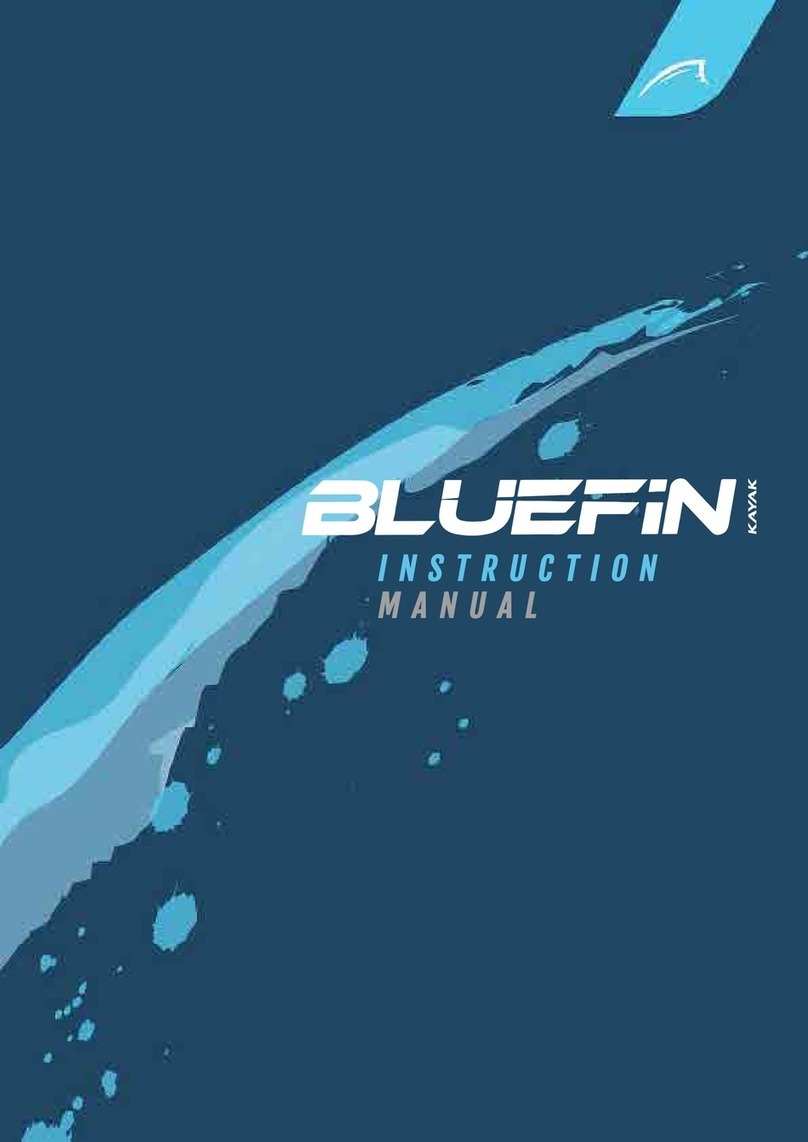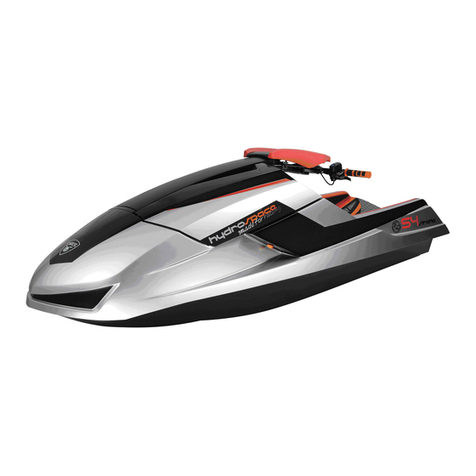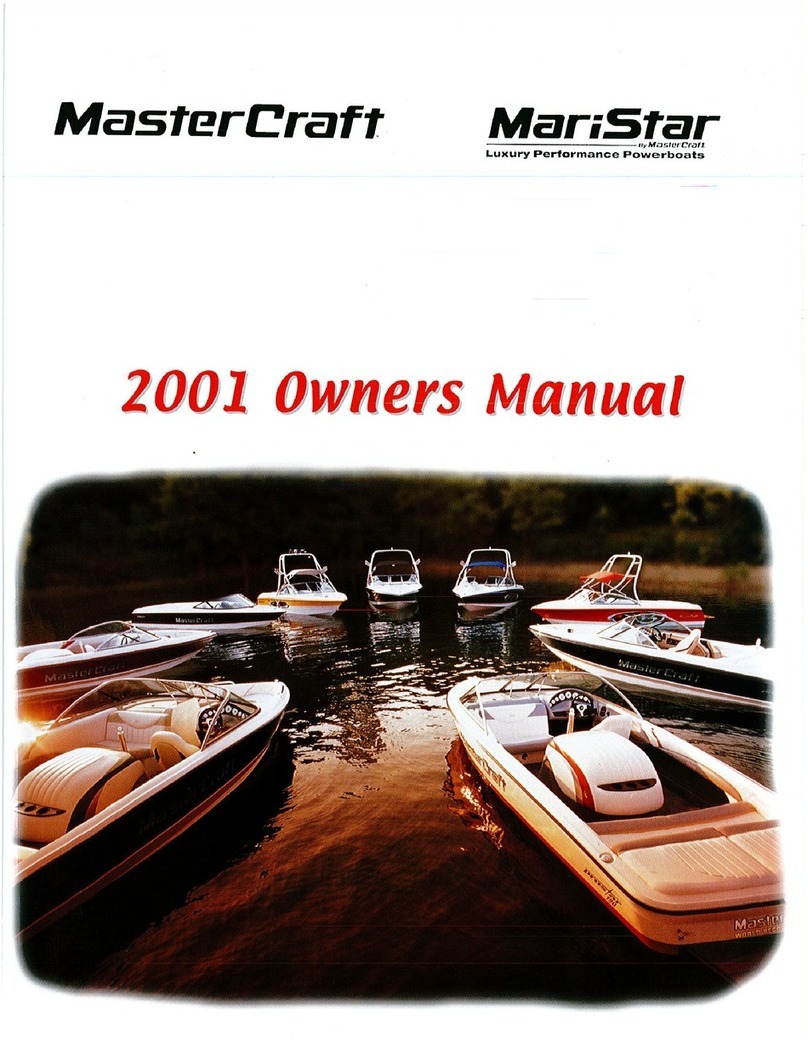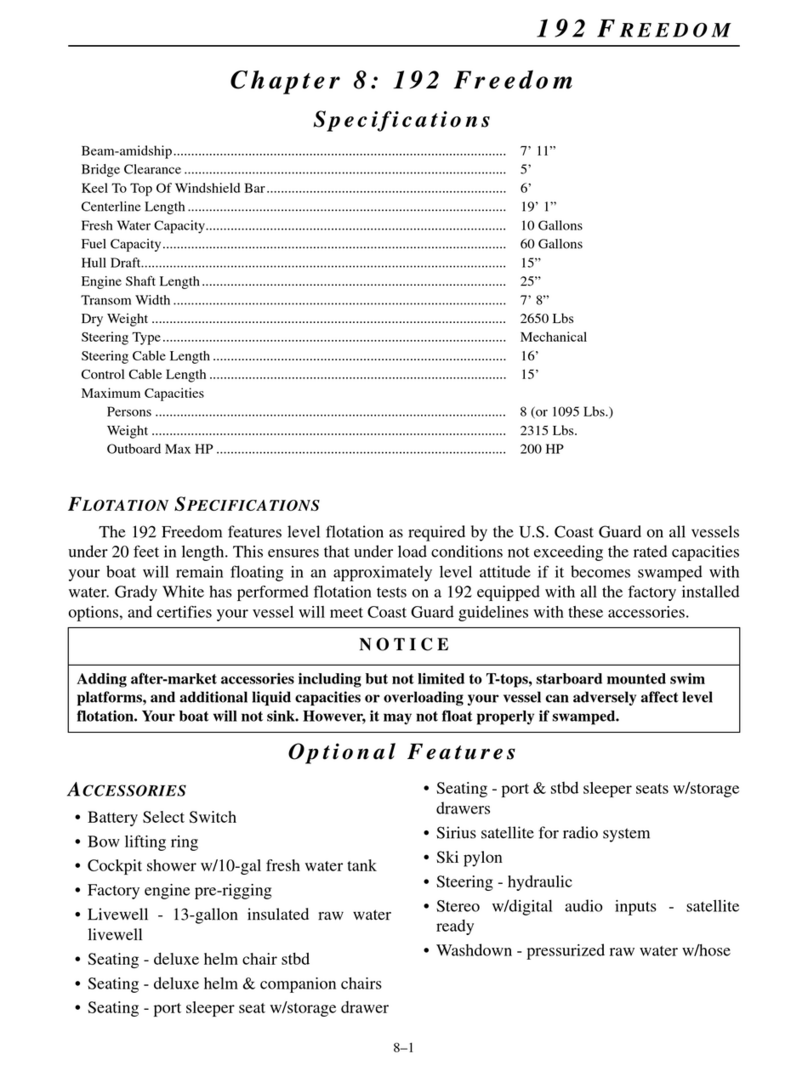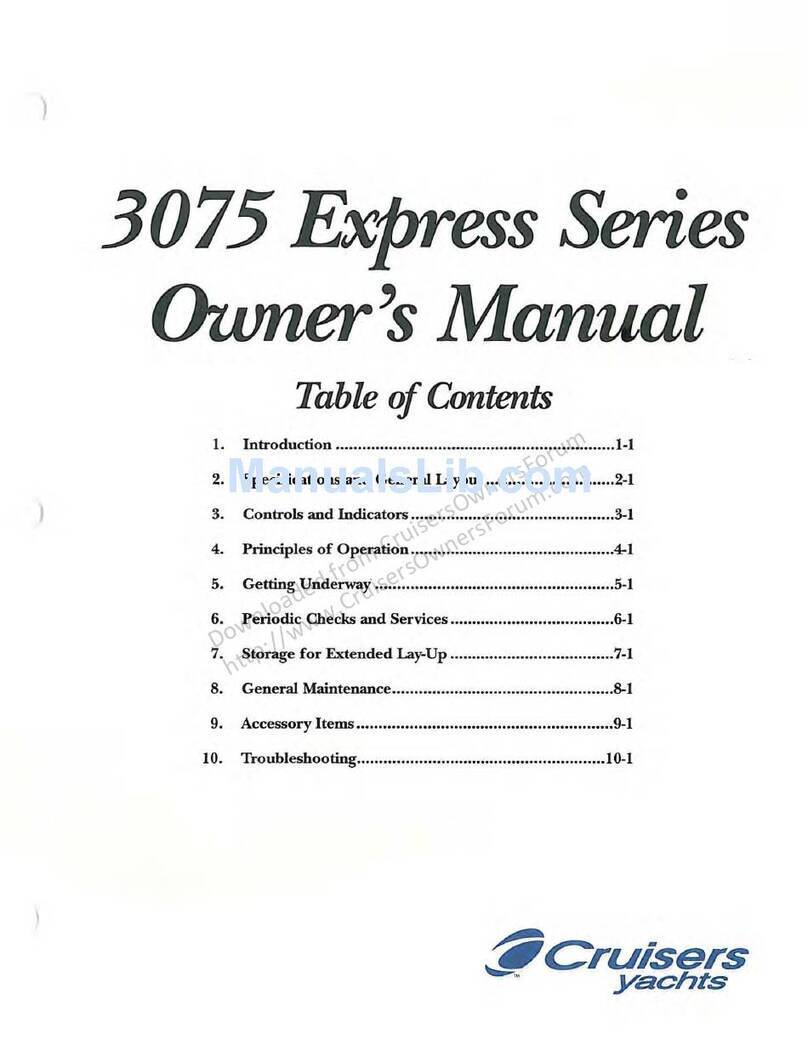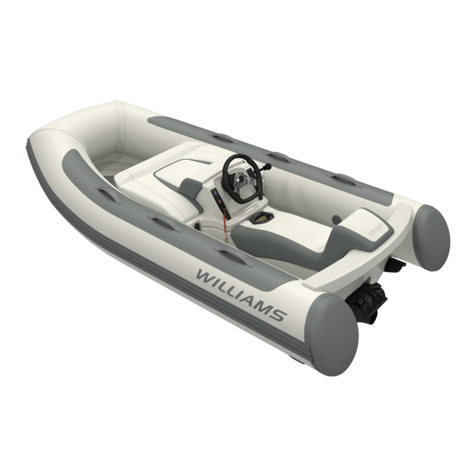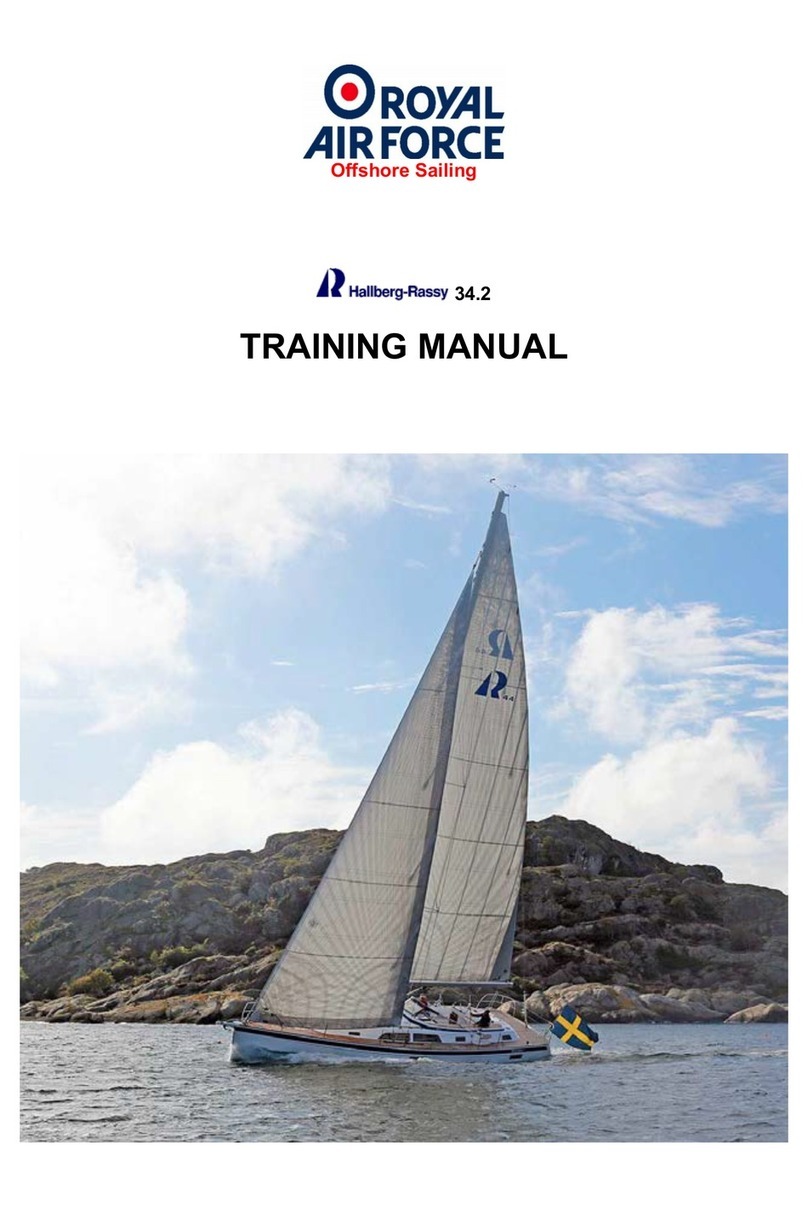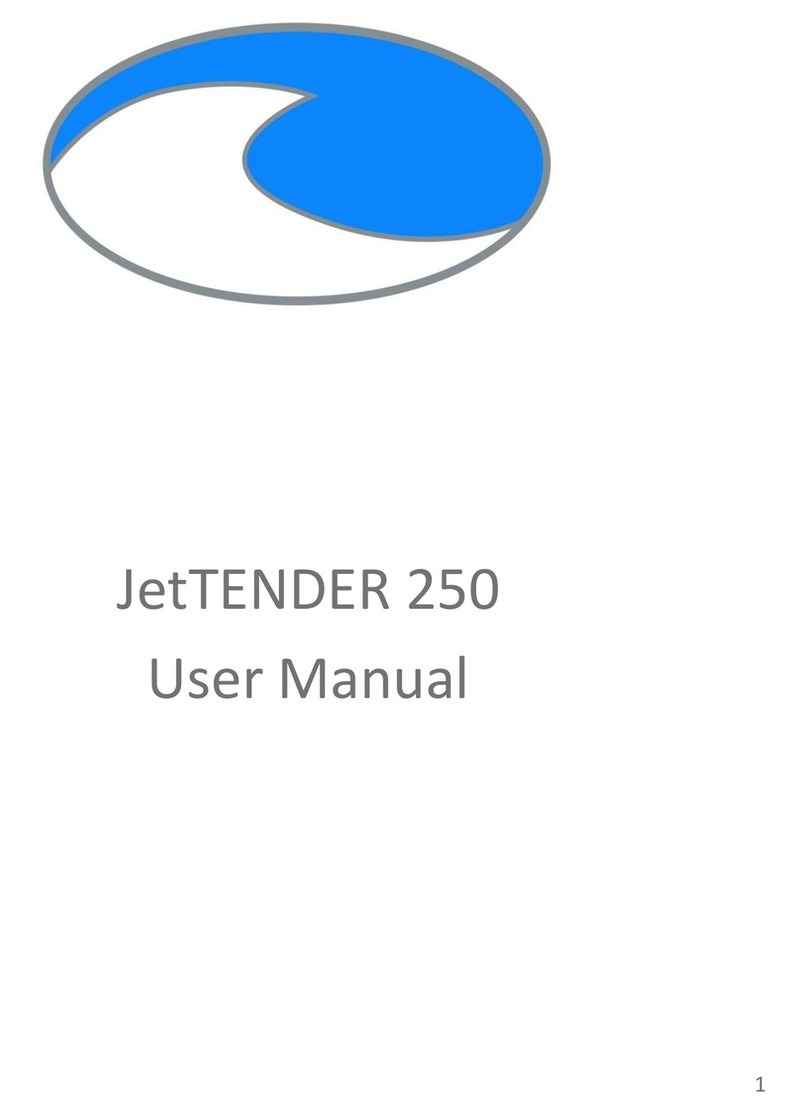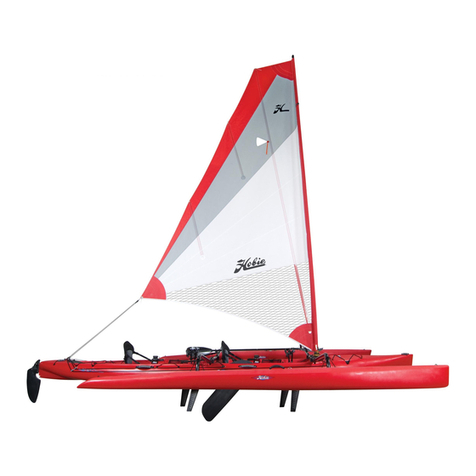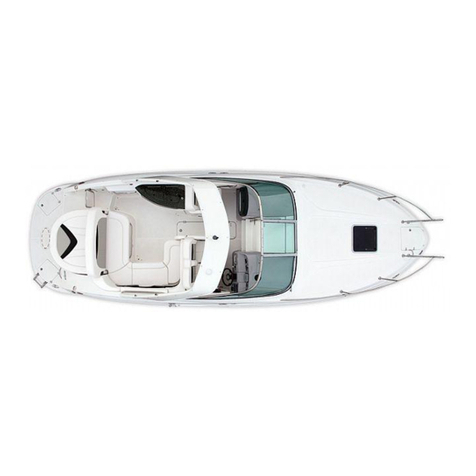Ship Harbor Yacht Charters RESPITE User manual

OPERATION MANUAL
RESPITE
Welcome Aboard!
We are happy that you have chosen Ship Harbor Yacht Charters and the
vessel RESPITE for your vacation. We hope you enjoy your cruising
experience in the lovely islands of the Pacific Northwest.
Respite; (res-pit) “a short period of rest from something difficult or
tiring”, we hope you enjoy your respite as much as we do.
This manual will help you become more familiar with your boat. If you
have any further questions, about the boat or your itinerary, please do
not hesitate to ask the SHYC staff.
Remember our vessels are non-smoking boats.
Bon Voyage!
The Ship Harbor Yacht Charters Staff

2
TABLE OF CONTENTS
Boat Operation Page
Engine Inspection 3
Start-Up & Shutdown
Getting Underway 4
Cruising & Docking
Fueling
Boat Electrical
A.C. (Shore) Power 5
Inverter
D.C. (House) Systems 6
Batteries
Sanitation System 7
Marine Toilet
Holding Tank(s)
Y-Valve
Water Systems 8
Fresh Water Tanks & Pumps
Hot Water
Shower
Galley 9
Propane
Refrigeration
Heating Systems 9
Diesel Heater (DC)
Electric Cabin Heat (AC)
Engine Generated (DC)
Electronics 10
VHF Radio, Depth Sounder, Radar
GPS/Plotter
Autopilot
Stereos/TV/DVD
Anchoring 10
Bar-B-Que 11
Dinghy/ Outboard 11
Safety 12
Cruising Restrictions
M.O. B.
Dead Heads/ Debris
Crabbing/Fishing 12

3
BOAT OPERATION
Engine Inspection
Remember your “WOBBS” every morning. (Water (Coolant), Oil, Bilges (Inspect and
Pump-out), Belts, and Sea Strainer. Check the level of COOLANT in the expansion
tanks. Check the level of your engine oil with the dipsticks. Your dipsticks are located at
the top rear of each engine in the middle of the engine room. They are most easily
accessed by removing the narrow engine hatch in the main salon.Look at the etch
mark on each dipstick that indicate proper levels. DO NOT OVERFILL! Only fill if oil levels
are below the ½ mark. Check the general condition of the hoses and belts.
Ensure the valves on each RAW WATER THRU-HULL are OPEN! (Lever in-line with valve).
Observe through the glass of each sea strainer for debris. If necessary, close the thru-
hull, open the strainer lid, clean out debris, and reassemble. REOPEN the Thru-hull!
Start Up
Having finished your inspection, start your engines from the lower helm station. Ensure
that Gearshifts are in neutral or the engines will not start (neutral lockout) Run your
throttles up and bring back to just above the idle position. Inset both keys into the
ignition and turn the key starting with the starboard engine.
Turn the key clockwise until the engine alarm sounds and pre-heat the engine. After
10-30 seconds turn key fully to engage the engine. If the engine does not turn over,
move the gearshift slightly while turning the key until the engine engages. If the engine
cranks slowly, check the condition of your batteries at the electrical panel. If the battery
is low, engage the Battery Parallel Switch located on the switch control panel to connect
other batteries. After the engine has started, return Battery Parallel Switch to “Off”.
After the engine starts, warm it up at about 1000rpms for about 5 minutes. Observe
your gauge readings. Oil pressure reads around 60 psi and water temp around 180 when
warm, the port engine may read a little higher approximately 190-195 degrees. Engine
temperature should rise very slowly.
Note: If water temp.is high or oil pressure low, shut down engine and look for problem.
Was there a lack of water exiting with exhaust? Are thru-hulls open and debris cleared
from sea-strainer? If problem keeps occurring, call SHYC Service.
Shut Down
Before shutting down, let engines idle for about 5 minutes letting them cool. Ensure
each gearshift is in the neutral position and each throttle is in idle. Turn off the engines.

4
Getting Underway
Disconnect the shore power cord (see AC Power next page). Close portholes, windows,
and hatches. Turn on VHF and electronics. Assign crewmembers to their tasks. Once
outside marina, have crew members bring in fenders and put lines away.
Cruising
All close quarter maneuving should always take place at the upper helm. Make certain
the throttles are in idle and engage the gearshifts. Slowly come up to cruising speed of
1800 rpms. If you run at 1800 rpms, you will cruise at approx. 9-10 knots, using only 6
gallons of diesel/hour. Your speed may vary depending on weight, load, and weather
conditions. Trim Tabs can bring the bow down to the idle cruising position. Watch your
speed on the GPS as you adjust.
Note: Avoid high engine speeds as it causes the engine to overheat causing damage as
well as high fuel consumption.
Docking
During docking, use the upper helm for the best visibility. Give clear instructions to the
crew on what you will expect of them i.e. with lines and fenders. Open the fly bridge
windows for easy & clear communication.
Ensure trim tabs are rocked back up for slow speed backing. While moving slowly
towards the dock, center the wheel and use the gears and throttles to maneuver the
vessel. Throttles should only be used in moderate to windy conditions. Otherwise, the
use of the transmission should be sufficient.
Fueling
Open filler caps located on the port and starboard deck trails (marked DIESEL) with the
deck-fitting key kept in the book basket on the port side salon dash. MAKE SURE YOU
HAVE DIESEL!Make sure it is going into the right deck fill! DOUBLE-CHECK! Before
pumping, have your oil/fuel sorb ready to soak up any spilled fuel. You should have a
rough idea of how many galleons you will need, but have someone check the fuel gauge
periodically by turning on the key.
Fuel gages at ¾ you need about 50 gallons (total)
“ “ “ ½ “ “ “ 90 gallons
“ “ “ ¼ “ “ “ 140 gallons
“ “ just above E “ “ 170 gallons
Put Diesel nozzle into the deck fitting and pump slowly listening to the sound of the flow.
Pumping too fast may not allow excess air to escape, which will lead to spillage out the
vent. As the tank fills, the sound will rise in pitch or gurgle. Pay attention to the vent
that it does not spill fuel into the water. Top off carefully, catching any spillage with
your sorb.
Check your gauges and if you have a sight gauge in the engine room, double-check they
are open and filled! Replace the deck fill caps and turn on the engine room blowers for a
few minutes. Clean up any spatter and wash hands thoroughly.

5
BOAT ELECTRICAL
The electrical system is divided into two distribution systems: 110 volt or AC and 12 volt
or DC. The systems are controlled from the electrical panel located behind the glass
panels on the starboard side of the salon at the end of the couch, and the battery
switches located at the helm in the cabinet under the throttle / shift controls.
When not connected to shore power your batteries provide most of your electrical
power. Therefore the use of onboard electricity needs to be monitored very carefully.
Turn off electrical devices when they are not being used (lights, instruments, etc.)
110 Volt or AC (Alternating Current)
Shore Power supports all AC equipment and receptacles on board as well as the battery
charger.
To connect to shore power, plug the power cord into the boat and then into the dock
receptacle. Check your power rating/plug size of the dock receptacle (i.e. 30amp, 20
amp etc.) If necessary, add an adaptor located in the storage locker on the aft deck.
Secure the cord around the shore power electrical receptacle and off the bow (i.e. wrap
around bowline a few times) turn the dock power breaker on.
On the boat, turn the shore circuit breaker on at the electrical panel. Turn on
appropriate breakers for battery chargers, (line 1 is for start bank and line 2 is the
house/inverter bank), water heater, and other desired loads. Watch your voltmeter for
load. If the load exceeds the voltage, it will pop the breaker. If this occurs, wait to turn
on one of your systems (i.e. water heater) until the use of power decreases.
Inverter
The inverter provides AC power to the 110 receptacle plugs (i.e. microwave) when the
boat is disconnected from shore power. The inverter does not supply power to the water
heater or battery charger. Your inverter remote control panel (on/off) and read out for the
inverter is located on the starboard side of the stair well by the lower helm. NOTE; this
switch must be on when using shore power as the inverter / charger charges the house
batteries. Make certain it is on. The inverter is located under the couch forward cushion;
there is a power switch and charging meter on the inverter. It is powered by 4 golf cart
batteries located forward of the port engine. Access is gained to these batteries through a
panel in the 3rd state room. The amount of DC power is limited to the capacity of these
batteries so use it very sparingly!!! This means use of the toaster, hair dryer,
microwave, coffee maker etc. must be limited!
When connected to shore power, the inverter acts as a battery charger for the 12-volt
house batteries. Should you detect the inverter failing to charge the house batteries,
check the circuit breaker on the AC panel and the inverter panel to make certain that it
is on. There is usually a circuit breaker located on the inverter itself that can get tripped
during a surge of power.

6
House 12-volt System
Three battery banks support your 12 volt system: #1 Port Engine Start #2 Starboard
Engine Start #3 House / Inverter Battery Bank
Your battery switches are located in the lower cabinet at the helm. Normally you will
leave the switches in the on position. Note: Changing the position of the battery
switches with the engine running will cause damage! Only change positions with the
engine off!
Your 12 volt panel shows all the systems supported by your batteries. Primarily you will
be turning on these breakers for lights, water pressure, electronics, etc. Bilge pumps
will always be left on.
When disconnected from shore power, the 12–volt systems will drain the battery
especially when at anchor. Monitor your batteries very carefully. The DC voltmeter on
the DC panel can be switched between your battery banks to measure battery voltage.
Typically the bank should read from about 13.0 to 14.5 volts when being charged. While
at rest, your voltage will drop as indicated in the figures below.
All your batteries are charged while underway by the alternator. The engine and house
batteries are charged by the battery charger/inverter while connected to shore power.
Ensure that the line #1 charger is on as well as the inverter charger line #2 and the
remote switch as indicated above.
Voltage Battery State of Charge
12.65 volts 100% 12.25 volts 50 %
12.47 volts 75 %11.95 volts 25 %
11.70 volts 0 %
Note: If the house/inverter batteries are ran extremely low (below 7.2 volts) the
inverter charger will not start charging them until the voltage is restored to 7.2 volts or
higher. This can be done by running the starboard engine and using the alternator to
charge the battery to a minimum (7.2) volts.

7
SANITATION SYSTEM
Marine Toilet
It is imperative that every member of the crew be informed on the proper use of a
marine head. The valves, openings, and pumps are small and will clog easily. If the
head gets clogged, it is your responsibility! Always pump the head for small children so
you can be certain of what is being flushed. Note: Never put in paper towels, napkins,
sanitary products, household T.P., or food into marine heads. Use only marine T.P.
provided by SHYC.
To use toilet, move selector switch to the “wet bowl” position. Pump the handle 3-5
times to wet the bowl. After using head, pump to remove waste from bowl (approx. 20
times). Then return selector back to “dry bowl” position and pump for a few times until
bowl is dry.
Should the toilet squeak or be a bit sticky to pump, lubricate with a couple of squirts of
dish soap or salad oil. Put in bowl and pump 2-3 times to get it to pump and leave
overnight. Again, leave in the “dry bowl” position.
Holding Tanks
Your sanitation holding tanks holds approx 30 gallons each. Be aware of the rate of
waste production (about 1 gallon/flush). If you overfill your tank, you will break a hose,
clog a vent, or burst the tank which is an indescribable catastrophe! And a very
expensive fix for you. Empty the tank at least every other day to avoid any problems.
The holding tank full red light is located in each head. Stop using the head and plan to
pump it out. The holding tank is emptied in one of two ways:
#1 At the pump-out station, remove the deck waste cap located on the starboard side,
one aft and one forward on the deck trail, READ THE CAP.Insert the pump-out nozzle
into the waste opening. Double-check that you have the right deck opening! Turn on
the pump on the dock and open the valve on the handle of the hose. When pumping is
finished, close lever on handle and turn off pump. Remove from deck fill.
If there is a fresh water hose on the dock, rinse the tank by adding water for 1-2
minutes. Then re-pump to leave the tank rinsed and clean for the benefit of the next
charterer. This also eliminates any head odors.
#2 the tank’s contents can also be discharged at sea by using the macerator. To operate
the macerator, depress both spring loaded macerator switches at the same time and
hold them. They are located at the top (aft holding tank) and bottom (forward holding
tank) of the 12 volt panel. Have someone visually watch the sewage flow from the
starboard side of the boat front and back. When the flow stops you are done. This
should take about 2 minutes. Note: Overboard discharge is only allowed in Canadian
waters. It is illegal to discharge overboard within U.S. waters.
Y-Valve
The Y valve directs the flow of waste into the holding tank or directly overboard. The Y
Valve is located in the aft cabin under the shelf closest to the stern. To flush directly
overboard, move the handle in line with the overboard hose. Usually, because of Coast
Guard regulations the Y- Valve will be wire-tied to the holding tank position.

8
WATER SYSTEM
Fresh Water Tank/ Pump/ Hot Water Heater
The fresh water tank holds approximately 70 gallons and is located under the aft
stateroom berth. Observe the water level by gauge on the electric panel. To fill the tank,
remove the deck water fill cap located starboard side of stairs. Fill the tank avoiding
flushing debris into the tank. Do not fill water and diesel at the same time. Wastewater
from the sinks and showers drains overboard through various thru-hulls usually located
under the sinks.
The water pressure pump is located under the aft berth. Activate the pump by turning
on the breaker at the DC panel. If when in use, the pump continues to run, you are
either out of water or have an air lock, which can be corrected by opening a faucet. If
you run out of water, shut off pump.
The hot water heater has an 11-gallon capacity. It is heated when the AC breaker is on
while connected to shore power, and also heats when running the port engine.
Shower
Respite has two showers. However we have found the aft cabin shower to be by far the
most convenient to use. We recommend you have all your friends and family use the aft
shower. Of course you may use the forward shower if you wish. If you do, remember to
tightly close the door to the toilet paper, remove the towels from the towel rack, and
move the curtain completely around the room to protect from water getting in places
you don’t want it. You will need to hold in your hand the sink faucet sprayer to rinse off.
The most convenient method to shower and minimize use of precious water is as
follows:
Set the water mix valve to the temperature you wish.
Then use the thumb switch on the shower head to start and stop the water flow.
Take short “boat” showers by turning off the water between soaping and rinsing.
Please wipe down the shower stall and floor when finished to keep shower tidy.
When you are done with your shower remember to open the thumb valve and turn off
the mix valve.
When you visit a harbor never miss an opportunity to fill up the water tank.

9
GALLEY
The boat is equipped with a low pressure propane system for cooking. The propane tank
is located in the bottom of the storage box on the aft deck under the shelf. There is a
propane solenoid switch to turn on the gas under the counter by the sink. When lighting
the first time, allow a few seconds for the gas to travel from the tank to the stove. You
might need to keep the stove top or the oven in the light position for a few more
seconds while the thermo-coupler warms up. The oven is lit with a BBQ lighter, set the
knob to light and hold the gas button down on the port side of the oven control panel
and light the pilot light under the burner, then you can adjust to the desired temp.
To ensure safety, turn off the propane solenoid switch, the propane at the bottle, and
the DC breaker when finished.
Refrigerator
The refrigerator is 12 volt only and is always drawing 12 volts unless you turn it off
inside the refrigerator. Carefully monitor the use of the refrigerator when the engines
are not charging the 12-volt system as when you are at anchor. Use a cooler when
possible for all your drinks to keep the refrigerator door closed as much as possible.
It can be turned down at night to conserve energy while anchored or moored.
HEAT
The Espar diesel forced-air heater is located on the aft engine room bulk head to the
port side. It is accessed through the removable panel in the aft state room. It provides
heat much like your household furnace. Turn on the switch on the control unit located
on the forward end of the electrical cabinet set the temperature at the desired
temperature. Check the exhaust port on the port midship to make certain that no
obstruction such as a fender or line exists. Let the furnace run at least 15 minutes
before turning it off. Turn the furnace off back at the thermostat.
Electric heat is also available when connected to shore power. Make sure the
appropriate AC breaker is on, and push the power button on the control pad by the
dinette to turn it on then set your temp.
Cabin heat is also available through a “red Dot” heat system when the engine is running.
Press the rocker switch located in the companionway to the appropriate setting. When
the engine is not running, turn off to conserve heat.

10
ELECTRONICS
There are two VHF radios, at the lower helm it is located over head, on the fly bridge it
is in the compartment to the lower port side. Make sure the breaker is on at the DC
Panel. Always monitor Channel 16 while underway.
There is one dedicated depth sounder on the fly bridge and it is controlled with the
switch on the panel.
The sounder is reliable in waters less then 200 feet and at slower speeds. If your
reading is blinking, it might be a false reading due to excessive depths or strong
currents! Watch your depth carefully in cruising unknown waters that might have rocks
or obstacles.
Furuno Radar; To operate the radar press and hold the power button. To turn off, hold
the power button for about 3 seconds. Remember you are not allowed to travel in fog or
at night.
A Garmin 545 GPS/ chart plotter/fish finder is located at the upper helm. Turn on by
depressing the power button. Press the select button to scroll through the functions.
The garmin also has the depth sounder.
A Robertson / Simrad Autopilot is located at the upper helm and lower helm.
1. To operate this unit turn it on by pressing the standby button.
2. As you cruise the unit will read out your current heading.
3. To engage the automatic piloting ability of the unit push the Auto button. The
autopilot will take control of the rudders.
4. You will be able to steer the boat while the autopilot is engaged BUT the autopilot will
continue to work to put the boat back on the course you selected when you pushed the
Auto button.
5. To change course (heading) while the autopilot is in control just turn the
black wheel on the autopilot. Each click will turn the boat one degree port or starboard.
6. To disengage the auto pilot push the standby button.
7. Remember to disengage the autopilot while you are on a straight course before
entering a harbor or attempting to moor or anchor. You want the rudder to be in it’s
neutral position as you attempt these maneuvers.
Stereos; There are 3 stereos, the one in the salon is compatable with smart phone /
Ipod etc… the stereo on the fly bridge is as well, the one in the aft state room is “old
school” with a cassette.
TV and DVD player are in the forward state room on the wall, they can be moved to the
salon as the base for the TV is next to the remote controls.
ANCHORING
Your primary working anchor, a plow, is attached to 100’ of chain and 200’ feet of line.
It is marked every 25’.
Turn on the anchor windlass on the AC panel and proceed to raise and lower the anchor
as needed. Be sure to always have your engines running. See page 9 in the White
Binder for further anchoring instructions. Turn off the breaker when finished.

11
BARBEQUE
The Barbeque is mounted on the rail on the aft deck; the BBQ tools are stored inside of
it in a pouch. It uses the green bottles and you will find 2 in the storage locker on the aft
deck.
Attach the propane bottle and carefully light the unit. This Barbeque cooks fairly hot
and fast so keep a good eye on your food. Please wipe it down with a rag or paper
towel. Note: Propane bottles are not stocked by SHYC so you will need to purchase a
bottle if one is not found on board during your check-out. Ensure that outboard gas or
any other flammables are not near barbeque.
DINGHY AND OUTBOARD MOTOR
Your 10.3” west marine dinghy is equipped with a 9.8 hp tohatsu engine. If not on the
dinghy it is stored on the aft rail on the outboard pad. It has a capacity of 1144LB
pounds or about 4 people.
To deploy the dinghy, untie the pulley rope and lower it in a controlled manner, while
the davits are still attached to the boat install the outboard on the transom. Make sure
the clamps are secure before letting go of the engine. Connect the fuel hose and prime
it, open the tank vent and pull the choke on the engine, set the throttle to start and pull
the rope, it usually starts on the 1st or 2nd pull. Unhook from the davits and deploy the
fender by the metal strong arm (to protect your boat and others).
Hoist dinghy in reverse order. But make sure the line is secure and the oars are stowed
securely in the strapped position inside the dinghy.
After the dinghy is in the water and readied to go (PFDs etc),Make sure outboard is in
neutral. While there is extra outboard gas on board, if you need to add more mix
gasoline with 2-cycle motor oil at a ratio of 50:1. Note: Failure to use proper mix will
damage outboard.
Please use extreme care in beaching your dinghy. Make sure the engine gets tilted up a
safe distance from shore so the prop does not hit the bottom or shear the pin. Do not
drag the boat on the beach. Please lift it up with your crew. Make sure it is secured as
the tide comes in fast in these here parts.
When returning to the boat, leave your shore shoes in the cockpit and slip on your deck
shoes or slippers to keep the boat neat and tidy.

12
OTHER NOTES
Safety should be paramount to your daily cruising. A man overboard drill (person?)
should be discussed and practiced with an unlucky PFD as the victim. (please rinse and
dry afterward before stowing). Remember that your lifejackets are stowed under the
forward bunk and in the third state room closet. A few should always be readily
available. Flares and other safety equipment are located on the fly bridge under the
port cushion in the personal safety bag.
Always have a sharp lookout posted for logs, deadheads, or other flotsam and jetsam. A
log hitting your prop can ruin your vacation. As you are traveling, the debris does seem
to gather along current lines. It is sometimes best to go around these areas and miss
the “mine fields”.
Respite is equipped with numerous automatic bilges pumps that can be activated on the
DC panel. The switch should normally be left in the “Auto” position can be switched for
a minute or so to “manual” to pump the bilge. If you continually hear the bilge pump
running, check your bilge! You may have a serious problem!
An auxiliary hand-operated bilge pump is located under the bed in the aft cabin and
operated by pumping the handle, This is used in an emergency situation.
The engine spares are located under the forward birth they include extra oil filters,
impellers, head parts, etc. Extra oil and coolant is located in the engine room.
Crabbing is fun but requires the correct license and season. Please be sure not to crab
off the stern as the crab line can easily get tangled in your prop as you swing with wind
or current. You certainly don’t want to be the person who has to dive over and cut the
line out of the propeller. It is best to use the dinghy to set your crab pot/ring away from
the boat. A partially open can of seafood catfood works well as any other bait and is
less messy. Please clean up any seaweed of crab shells afterwards to keep the boat
neat and tidy.
Table of contents
Other Ship Harbor Yacht Charters Boat manuals

Ship Harbor Yacht Charters
Ship Harbor Yacht Charters Chinook Beneteau Idylle 11.50 User manual

Ship Harbor Yacht Charters
Ship Harbor Yacht Charters OHANA User manual
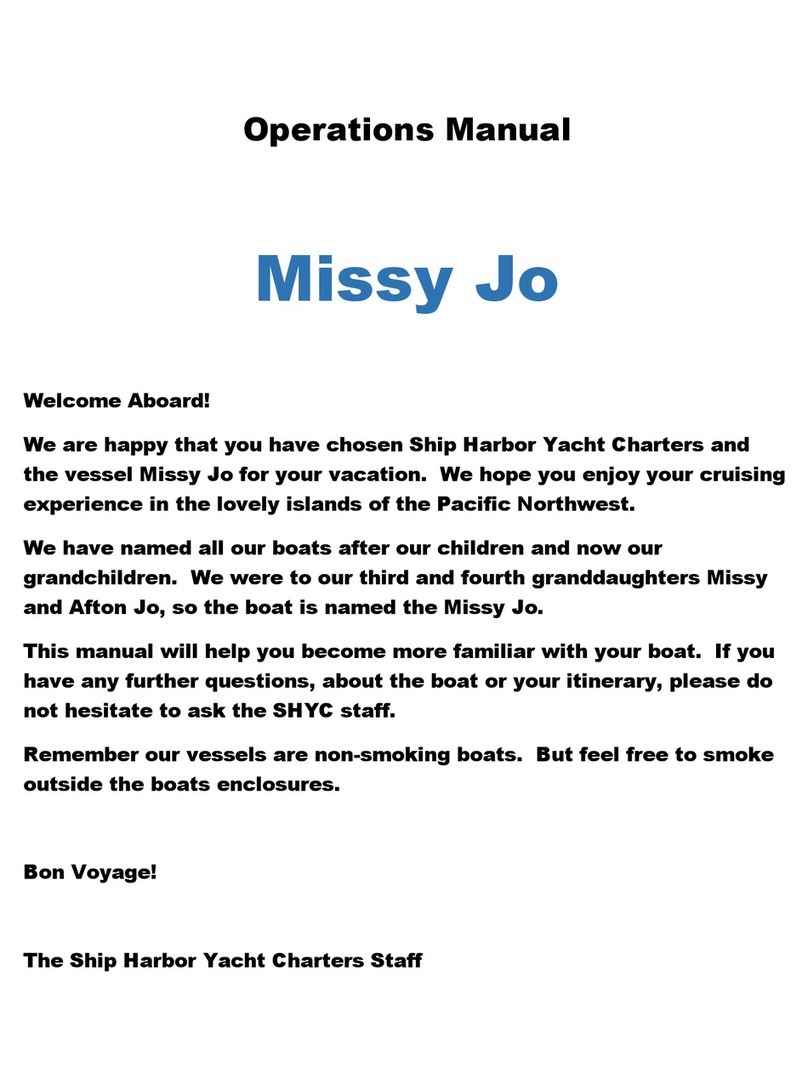
Ship Harbor Yacht Charters
Ship Harbor Yacht Charters Missy Jo User manual

Ship Harbor Yacht Charters
Ship Harbor Yacht Charters Mary K User manual
